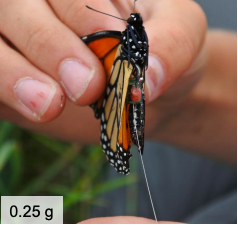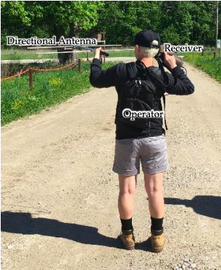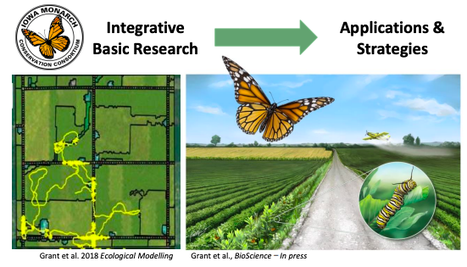|
By Amanda Brucchieri and Helen Craig Imagine biking down a road, along the edge of a cornfield with stalks reaching far above your head. Drifting across your path, riding the breeze, is a monarch butterfly. It flutters and then glides as butterflies do, looking for the next patch of flowers to feed and rest. Bursting from this peaceful scene comes a team of scientists with nets, scopes, and chirping walkie-talkies. They are on a mission. They are tracking the same monarch that had just coasted by using radio telemetry.  Image 1: Monarch with radio transmitter attached (courtesy of Dr. Kelsey Fisher) Image 1: Monarch with radio transmitter attached (courtesy of Dr. Kelsey Fisher) Radio telemetry uses radio signals to track the location of a given organism. There are three main components to radio telemetry: a small radio transmitter (which includes a battery and components to send a signal - see Image 1), an antennae system (which picks up the signal), and a radio signal receiver (which transforms the signal into a beeping sound). The radio transmitter is attached to the desired organism, and the researcher tracks the organism using the antennae and receiver. The closer the researcher is to the organism, the stronger is the signal received, similar to the childhood game ‘hot and cold’. Radio telemetry has frequently been used for observing movement in large mammalian populations, where scientists are able to attach large transmitters to vertebrate animals (Millspaugh & Marzluff et al. 2001). However, its use in tracking insect movement has only recently become popular (Kissling et al. 2014). Dr. Kelsey Fisher, an entomologist working at the Connecticut Agricultural Experiment Station, employed radio telemetry to track monarch butterflies in her graduate work. It is hypothesized that monarch butterfly overwintering populations have significantly declined due to the loss of their host plant, milkweed (Thogmartin, 2017). Thus, a lot of monarch conservation efforts have focused on the restoration of milkweed habitats. But this begs the question: where do we establish the milkweed? How does placement of milkweed habitats in a landscape impact the monarch’s movement and its utilization of it? To answer these questions, Fisher used radio telemetry to track and map the movement of monarch butterflies through different land cover types. She discovered that monarch butterflies can be influenced by stimuli from up to 125 meters, but most frequently from approximately 50 meters away (Fisher et al. 2020; Fisher & Bradbury 2022; Fisher, Adelman, & Bradbury 2020). This discovery has translated to recommendations for conservationists to establish milkweed habitat roughly 50 meters apart.  Image 2: Researcher holding all three a directional antenna, radio receiver, and operator. (courtesy of Dr. Kelsey Fisher) Image 2: Researcher holding all three a directional antenna, radio receiver, and operator. (courtesy of Dr. Kelsey Fisher) Research like that of Dr. Fisher’s is an incredible example of science evolving through innovation. As transmitters have become impressively smaller and lighter over time, the potential of radio telemetry technology has grown. However, the technology still has limits – transmitters weigh nearly as much as watch batteries and only larger and stronger insects, like monarchs and some beetles and dragonflies, can support their size and weight. Smaller insects that could physically shoulder the transmitter might have altered behavior (Wikelski et al. 2010). Radio telemetry also has a small range that aligns with “line of sight”, typically < 1 kilometer (Fisher et al. 2021). This makes it difficult to track strong and highly mobile insects, that can easily handle the extra transmitter weight, over long periods of time. Limitations of radio telemetry should not detract from its potential use in insect research. You just may need to change your approach. During the seminar, Dr. Fisher stressed the importance of picking the technology that can answer your question and understanding how to work with its limitations. To overcome the small range of radio telemetry, Dr. Fisher tracked the highly mobile monarchs over a short period of time and surrounded the area with people so the tagged individuals could be tracked and retrieved consistently and reliably (Image 2).  Image 3: Using radio telemetry and it’s broader applications for conservation (Grant et al. 2018; Grant et al 2022) Image 3: Using radio telemetry and it’s broader applications for conservation (Grant et al. 2018; Grant et al 2022) Conducting research on insect movement through various techniques, including radio telemetry, can significantly expand our understanding of how insects traverse the landscape. For beneficial species, this can translate to conservation practices that ensure the species efficiently utilize their habitat, thereby increasing their reproductive output and population numbers (Image 3). For pest and invasive species, this can translate to monitoring techniques and development of appropriate control measures. As our time came to an end, Dr. Fisher encouraged us to speak to people with the appropriate expertise before deciding on a new technology. Sometimes, all that is needed to turn an idea into a successful action is finding the right person, training, or resources. Branch out and you may find yourself homing in on an incredible opportunity. Citations: Daniel Kissling, W., Pattemore, D. E., & Hagen, M. (2014). Challenges and prospects in the telemetry of insects. Biological Reviews, 89(3), 511-530. Fisher, K. E., Adelman, J. S., & Bradbury, S. P. (2020). Employing very high frequency (VHF) radio telemetry to recreate monarch butterfly flight paths. Environmental Entomology, 49(2), 312-323. Fisher, K. E., & Bradbury, S. P. (2022). Influence of habitat quality and resource density on breeding‐season female monarch butterfly Danaus plexippus movement and space use in north‐central USA agroecosystem landscapes. Journal of Applied Ecology, 59(2), 431-443. Fisher, K. E., & Bradbury, S. P. (2021). Estimating perceptual range of female monarch butterflies (Danaus plexippus) to potted vegetative common milkweed (Asclepias syriaca) and blooming nectar resources. Environmental Entomology, 50(5), 1028-1036. Fisher, K. E., Dixon, P. M., Han, G., Adelman, J. S., & Bradbury, S. P. (2021). Locating large insects using automated VHF radio telemetry with a multi‐antennae array. Methods in Ecology and Evolution, 12(3), 494-506. Grant, T. J., Parry, H. R., Zalucki, M. P., & Bradbury, S. P. (2018). Predicting monarch butterfly (Danaus plexippus) movement and egg-laying with a spatially-explicit agent-based model: the role of monarch perceptual range and spatial memory. Ecological Modelling, 374, 37-50. Grant, T. J., Fisher, K. E., Krishnan, N., Mullins, A. N., Hellmich, R. L., Sappington, T. W., ... & Bradbury, S. P. (2022). Monarch butterfly ecology, behavior, and vulnerabilities in north central United States agricultural landscapes. BioScience, 72(12), 1176-1203. Millspaugh, J., & Marzluff, J. M. (Eds.). (2001). Radio tracking and animal populations. Academic Press. Thogmartin, W. E., López-Hoffman, L., Rohweder, J., Diffendorfer, J., Drum, R., Semmens, D., ... & Wiederholt, R. (2017). Restoring monarch butterfly habitat in the Midwestern US:‘all hands on deck’. Environmental Research Letters, 12(7), 074005. Wikelski, M., Moxley, J., Eaton-Mordas, A., López-Uribe, M. M., Holland, R., Moskowitz, D., ... & Kays, R. (2010). Large-range movements of neotropical orchid bees observed via radio telemetry. PLoS one, 5(5), e10738. Comments are closed.
|
Categories
All
Archives
June 2024
|
Department of Entomology
University of Maryland
4112 Plant Sciences Building
College Park, MD 20742-4454
USA
Telephone: 301.405.3911
Fax: 301.314.9290
University of Maryland
4112 Plant Sciences Building
College Park, MD 20742-4454
USA
Telephone: 301.405.3911
Fax: 301.314.9290

 RSS Feed
RSS Feed




